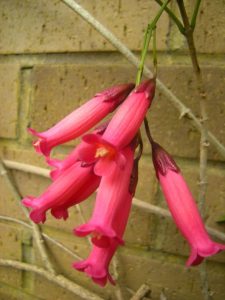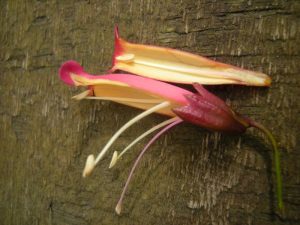Campsidium valdivianum is a weak woody climber with us, in its native Chile it grows to 15 metres. Found at low altitudes 500m – 2000m in interior valleys and on the coastal mountains. Seed was collected from plants growing on the margin of remnant forest in the Los Lagos region of southern Chile.
In the family Bignoniaceae racemes of bright lurid pink tubular flowers are held in the evergreen leaf axils of the previous year’s growth.
A bright, stunning colour that catches the eye. The white anthers grouped just proud of the corolla which splays into five flattened petals. On cutting open the corolla the filaments, loaded with tension, spring out relieved to be free of the constraining tube. Ants are attracted to the flowers by the nectar and often bore hole damage can be seen.
Twisting in anticlockwise spirals around a supporting plant gaining height to reach the light. The pinnate leaves usually comprise five pairs with one at the terminal. The midrib is prominent and indented on the upper surface giving a precise division of two halves.




3 Comments
3 Pingbacks